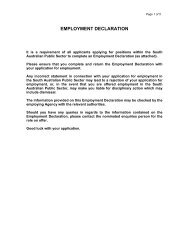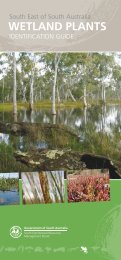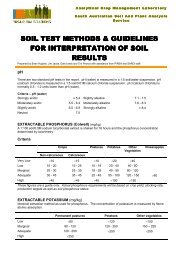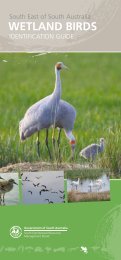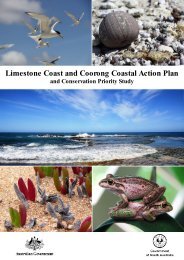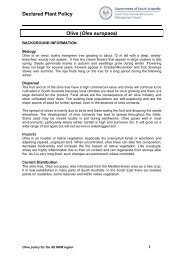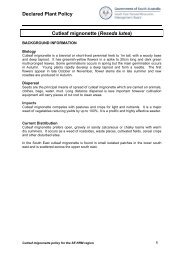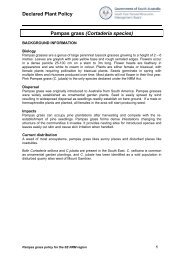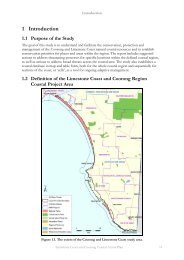Cell Descriptions - South East Natural Resources Management Board
Cell Descriptions - South East Natural Resources Management Board
Cell Descriptions - South East Natural Resources Management Board
Create successful ePaper yourself
Turn your PDF publications into a flip-book with our unique Google optimized e-Paper software.
SE15-17 – The Coorong<br />
Climate change<br />
element/ scenario<br />
Frequency continues<br />
to show great<br />
variation on a<br />
decadal scale.<br />
Intensity of large<br />
storms increases.<br />
Warmer average<br />
conditions:<br />
2030:+0.3 to.6 0 C<br />
2070:+1.5 to 2 0 C<br />
Drier average<br />
conditions:<br />
2030: -2% to 5%<br />
2070: - 10% to 20%<br />
‘Flashy’ run off:<br />
Drier creeks, but<br />
larger rare floods<br />
Groundwater<br />
lowering; saline<br />
incursion:<br />
Nearshore sea<br />
changes -<br />
temperature;<br />
acidity; wave<br />
climate:<br />
Impacts and implications Protect and manage Address landscape<br />
(for this cell) habitat threats issues: fire,<br />
connectivity,<br />
refuges, hydrology<br />
flooding above highest<br />
known tides. The lagoon and<br />
seasonal wetlands will be<br />
subject to storm tide<br />
inundation with a slight sea<br />
level rise; changing access<br />
and groundwater conditions<br />
within the cell.<br />
2070: Flooding will affect all<br />
swamps and adjacent low<br />
lying areas. Seasonal wetland<br />
areas adjacent to the<br />
<strong>South</strong>ern Lagoon will be<br />
flooded by the 2m<br />
inundation. Flooding above<br />
this level is much more<br />
extensive.<br />
Frequent storm damage to<br />
foredunes.<br />
(Impacts uncertain. Existing<br />
terrestrial vegetation is<br />
found in warmer conditions<br />
elsewhere)<br />
Native dune vegetation<br />
adapts well to drier<br />
conditions, but recovers<br />
more slowly from fire,<br />
disease and storm damage:<br />
dune mobilization becomes<br />
more likely. Exotic grass<br />
species within dunes unlikely<br />
to survive drought.<br />
Drains and creeks may<br />
increase sediment load to<br />
coastal swamps, (this<br />
depends on land<br />
management practices).<br />
The potential fall in<br />
groundwater pressure (and<br />
potential storm incursion) a<br />
significant threat to<br />
vegetation survival in<br />
freshwater swamps and in<br />
the dunes.<br />
Wave climate changes<br />
unlikely.<br />
impacts n the lagoon<br />
fringes. Continue aerial<br />
photographic<br />
monitoring.<br />
Active management of<br />
dune blowouts.<br />
Active weed control<br />
within dunes, together<br />
with management of<br />
blowouts.<br />
Maintain watching brief<br />
on sedimentation of<br />
swamps.<br />
Adaptive management<br />
of plant assets.<br />
Maintain<br />
connectivity of<br />
vegetation within<br />
the region.<br />
Monitor salinity of<br />
coastal swamps, and<br />
vegetation condition<br />
in the swamps and<br />
dunes.<br />
Limestone Coast and Coorong Coastal Action Plan 458



